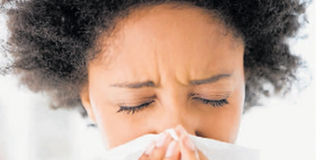Flu may mimic the signs of malaria

One of the methods of good personal hygiene during flu is to cover your cough and sneeze with a clean handkerchief or cloth.PHOTO|PIXABAY
What you need to know:
- She added that these symptoms had started suddenly and that she attended two nearby hospitals in her quest to test for malaria but her results read negative upon testing.
My patient narrated to me the symptoms that she suspected resembled malaria, such as severe headache, muscle pain, high fever, sore throat and runny nose.
She added that these symptoms had started suddenly and that she attended two nearby hospitals in her quest to test for malaria but her results read negative upon testing.
When I ran some tests and examinations on her, I found out that she was suffering from flu and not what she had been suspecting.
Upon revealing the results, the patient resisted and insisted on being prescribed antimalarial medication because all symptoms resembled malaria.
It took time for her to digest the fact that not all symptoms results into malaria.
She’s not the only one
My patient’s situation is not uncommon. Flu is a common infectious disease caused by an influenza virus. The virus attacks mainly the upper respiratory tract – the nose, throat and bronchi (air pipe) and rarely also the lungs.
This is among the so called self-limiting infections (resolves on their own) even though they are acutely debilitating. The symptoms of flu may mimic malaria and some other medical conditions such as high fever, runny nose, sore throat, muscle pains, malaise (feeling tired), headache and coughing which may last for a week.
How do you catch flu?
Large amounts of influenza virus are often present in respiratory secretions of infected persons as a result they are passed from one person to next through air droplets and small particles via sneezing or coughing and touching surfaces.
When the infected person coughs or sneezes, these particles enter the nose or throat of which may take an average of two days to develop symptoms.
A cold and dry weather allows the virus to survive longer outside the body and this explains why there is a seasonal variation of flu. Influenza is usually diagnosed based on symptoms (fever, runny nose, cough and muscle pain).
Lab testing is usually to exclude possibility of other infections with similar presentations. If left untreated, flu resolves on its own.
Remedies
The treatment of flu is mainly supportive and involves taking plenty of water, rest and some medication as directed by a physician to relieve fever and mucle pains. To facilitate quick recovery, one can also drink a hot cup of tea at intervals.
Tea contains a natural bronchidlator known as theophylline, which helps in clearing the airway. Honey also may be taken and it has many anti-oxidants. Also taking enough fluids is useful as it helps in mucus secretion. Flu can be prevented through good personal hygiene such as frequent hand washing with soap.




